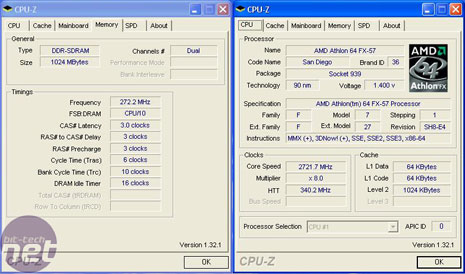BIOS:
ABIT uses a modified Award BIOS to allow the integration of its µGuru utility suite, giving the user an ample level of tweakability. Under the µGuru Utility menu, there are options to change the CPU operating speed, CPU multiplier, external CPU clock and PCI-Express frequency. The external CPU clock is adjustable from 200 to 400MHz, while the PCI-Express frequency is adjustable from 100 to 145MHz.The CPU voltage can be adjusted from 1.4V to 1.8V in 0.025V increments (dependant on the default core voltage - essentially it is default core voltage + 0.4V to attain the maximum voltage possible) and memory voltage can be adjusted from 2.5V to 2.7v in 0.05V steps and then all the way to 3.2V in 0.1V steps. The DDR reference voltage can also be adjusted between -60mV and +60mV in 10mV increments. The voltage options are somewhat subdued in comparison to the AN8-SLI, but there is ample control for the important voltage adjustments.
ABIT also includes a great selection of safeguard options under the ABIT EQ menu. It's possible to set beep warning and shutdown thresholds for operating temperatures, fan speeds and voltage monitoring too. It's also possible to temperature control the CPU, North Bridge, System and two other fan speeds (if there are fans installed), allowing you to select the amount of voltage sent to the fan at a high and low threshold - this should allow the user to eliminate more noise from the system by setting intelligent thresholds that work well with the installed hardware.
More tweak options can be found under the 'Advanced Chipset Features' menu. There are multiplier adjustments for K8<->NB HT Speed, NB-->SB HT Speed, NB<--SB HT Speed and you can also set the HT link width between K8<->NB and NB<->SB. Interestingly, there is no option to auto detect these values.
Under the DRAM configuration sub-menu (under Advanced Chipset Features), there is a plethora of memory tweaking options that are unlocked when DRAM Timing Selectable is set to manual. These include the following options: DRAM clock, CAS Latency Time, Row Cycle Time, Row Refresh Cycle Time, Min. RAS# Active Time, RAS# to CAS# Delay, RAS# Precharge Time, RAS# to RAS# Delay, Write Recovery Time, Write to Read Delay, Read to Write Delay, DRAM Command Rate, Bank Interleaving, Burst Length, MTRR Mapping Mode and 32-bit DRAM Memory Hole.
On the whole, the BIOS is pretty comprehensive and should cater for most enthusiasts needs. However, we feel that ABIT could have done more on the voltage adjustment front. Taking the tweakability of the rest of the BIOS into consideration, the voltage tweaking section does come across as a little bare for a high end enthusiast-orientated motherboard.
Overclocking & Stability:
We overclocked the board, and it did reasonably well. We managed to get the board running fully stable at 340MHz HTT with the memory running at 272MHz 3.0-3-3-8 with 2.9V vDIMM. We achieved this on the 8.0x multiplier without any stability problems at all. We were pretty impressed with this in all honesty. With the memory running in 1:1, we found that the board was unable to POST above 281MHz - we feel that this is a limit of the CPU we were using, as we've found it to encounter stability problems at similar speeds in the past.We ran around 64 hours of stress testing on this motherboard with bit-tech's stability suite comprising of 3DMark05, Prime95 and IOMeter to simultaneously stress all components on the motherboard. It is not a requirement for the motherboard to flawlessly complete the whole stress testing period and most don't make it through it. What it does do is weed out the motherboards that can't stand up to heavy abuse, as they fall over within the first couple of hours. Some boards we've tested have fallen over inside the first few minutes, too.
ABIT's AN8 32X survived well, despite our 3DMark05 loop crashing back to desktop after around 19 hours. Both Prime95 and IOMeter continued for the rest of the weekend until we stopped them on Monday morning. Before stopping them, we tested whether it was still possible to play games on the board, after the 3DMark05 error. We're pleased to say that it was able to play games, so we put the 3DMark05 crash down to application error - it's something that we've had on many occasions in the past.

MSI MPG Velox 100R Chassis Review
October 14 2021 | 15:04







Want to comment? Please log in.